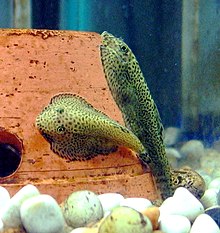
Acrossocheilus is a genus of ray-finned fishes in the family Cyprinidae, native to freshwater in China, Taiwan, Laos, and Vietnam. They are fairly small, no more than 30 cm (1 ft) in standard length.

Rhinogobius is a genus of primarily freshwater gobies native to tropical and temperate parts of eastern Asia. Most are small, streamlined in shape, and often sexually dimorphic. Few are of commercial importance, but R. duospilus is fairly widely traded as an aquarium fish.
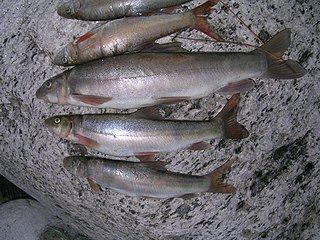
Schizothorax is a genus of cyprinid fish found in southern and western China, through northern South Asia (Himalaya) and Central Asia, to Iran, with a single species, S. prophylax, in Turkey. They are primarily found in highland rivers, streams and lakes, although a few species occur in lower-lying locations, like Lake Balkhash and lakes of the Sistan Basin. Their scientific name means "cloven-breast", from Ancient Greek schízeïn (σχίζειν) 'to cleave' and thórax (θώραξ) 'breast-plate'. The western species are typically referred to as marinkas from their Russian name marinka (маринка), while the eastern species are usually called snowtrout. Although they do resemble trouts in habitus this is merely due to convergent evolution and they are by no means closely related apart from both being Teleostei: Cyprinids are in the teleost superorder Ostariophysi, while trouts are in the superorder Protacanthopterygii. Their ancestors must thus have diverged as early as the Triassic, more than 200 million years ago.
Sinocyclocheilus is a genus of freshwater fish in the family Cyprinidae that is endemic to Guangxi, Guizhou and Yunnan in China. Almost all of its species live in or around caves and most of these have adaptions typical of cavefish such as a lack of scales, lack of pigmentation and reduced eyes. Several species have an unusual hunchbacked appearance and some of the cave-dwellers have a "horn" on the back, the function of which is unclear. In contrast, the Sinocyclocheilus species that live aboveground, as well as a few found underground, show no clear cavefish adaptions. They are relatively small fish reaching up to 23 cm (9.1 in) in length. The individual species have small ranges and populations, leading to the status of most of the evaluated species as threatened. Many species populations in the genus have yet to be evaluated by the IUCN.

Cobitis is a genus of small freshwater fish in the family Cobitidae from temperate and subtropical Eurasia. It contains the "typical spiny loaches", including the well-known spined loach of Europe. Similar spiny loaches, occurring generally south of the range of Cobitis, are nowadays separated in Sabanejewia.
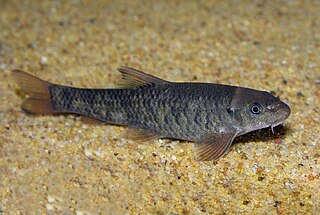
Garra is a genus of fish in the family Cyprinidae. These fish are one example of the "log suckers", sucker-mouthed barbs and other cyprinids commonly kept in aquaria to keep down algae. The doctor fish of Anatolia and the Middle East belongs in this genus. The majority of the more than 160 species of garras are native to Asia, but about one-fifth of the species are from Africa.

Hemimyzon is a genus of ray-finned fish in the family Balitoridae.
Oreonectes is a genus of fish in the family Nemacheilidae found in the rivers and caves of Asia. Many of these species are troglobitic.

Schistura is a genus of fish in the stone loach family Nemacheilidae native to the streams and rivers of the southern and eastern Asia. Some of these species are troglobitic.
Sinogastromyzon is a genus of hillstream loaches native to eastern Asia.

Triplophysa is a genus of fish in the family Nemacheilidae found mainly in and around the Qinghai-Tibet Plateau in China, as well as inland waters of the larger part of central Asia. They can be distinguished from other genera of Nemacheilidae by marked sexual dimorphism, including the development of nuptial tubercles on breeding males. Currently, the genus is a mixed assemblage of species. Some lineages have been identified and treated as subgenera, but as Wikipedia follows Fishbase for fish species all but Hedinichthys have been treated as subgenera in Wikipedia, although Kottelat in his revision of the loaches did recognise them as valid. FishBase, however, includes these in Triplophysa without specifying subgenera and treats the names given by Kottelat as synonyms.

Yunnanilus is a genus of small stone loaches that are endemic to southeastern China, especially Guangxi and Yunnan. They are found in rivers, streams and lakes; some species are restricted to caves.
Pareuchiloglanis is a genus of sisorid catfishes native to Asia. These species are rheophilic catfish chiefly found in the headwaters of major rivers in South and East Asia. They originate from the Brahmaputra drainage in India, east and south to the Yangtze drainage in China and the Annamese Cordillera drainages in southern Vietnam. Two species are known from the Mekong River: P. myzostoma and P. gracilicaudata. Four species are known from the drainage of China: P. abbreviatus, P. gracilicaudata, P. myzostoma and P. prolixdorsalis.
Beaufortia polylepis is a species of river loach. It is endemic to the Nanpan River in Yunnan, China. It inhabits rocky streams and measures 3.9–4.8 cm (1.5–1.9 in) standard length.
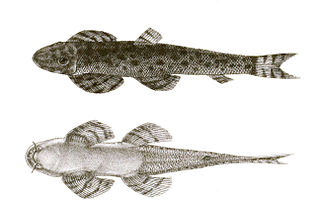
Balitora is a genus of fish in the family Balitoridae endemic to Asia.

Loaches are fish of the superfamily Cobitoidea. They are freshwater, benthic (bottom-dwelling) fish found in rivers and creeks throughout Eurasia and northern Africa. Loaches are among the most diverse groups of fish; the 1249 known species of Cobitoidea comprise about 107 genera divided among 9 families.
Paracobitis is a genus of Asian stone loaches.
Paraprotomyzon is a genus of gastromyzontid loaches endemic to China.

Vanmanenia is a genus of loaches from China and mainland Southeast Asia.
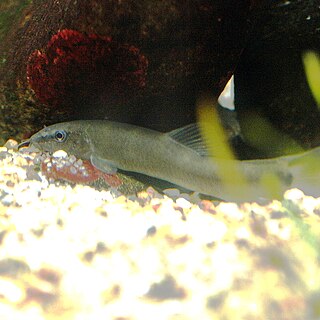
Parabotia is a genus of loaches. Most species in the genus are endemic to China, but P. curtis is from Japan, P. dubius is from Vietnam, and P. mantschuricus is from the Amur River basin.
